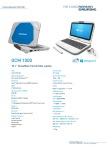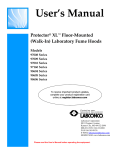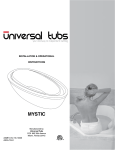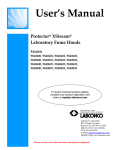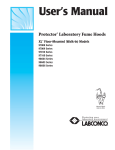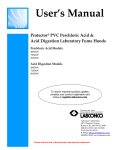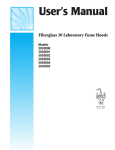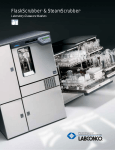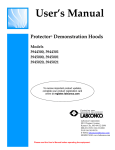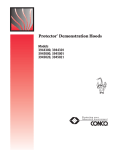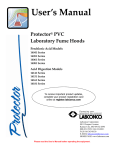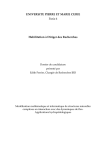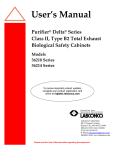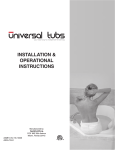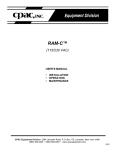Download Protector ClassMate Laboratory Fume Hoods User`s Manual
Transcript
User’s Manual Protector® ClassMate® Laboratory Fume Hoods Models 69704 Series 69706 Series 69715 Series 69705 Series 69714 Series 69716 Series To receive important product updates, complete your product registration card online at register.labconco.com Labconco Corporation 8811 Prospect Avenue Kansas City, MO 64132-2696 800-821-5525, 816-333-8811 FAX 816-363-0130 E-MAIL [email protected] HOME PAGE www.labconco.com Please read the User’s Manual before operating the equipment. Copyright © 2001, 2007 Labconco Corporation. All rights reserved. The information contained in this manual and the accompanying products are copyrighted and all rights reserved by Labconco Corporation. Labconco Corporation reserves the right to make periodic design changes without obligation to notify any person or entity of such change. Warranty Labconco provides a warranty on all parts and factory workmanship. The warranty includes areas of defective material and workmanship, provided such defect results from normal and proper use of the equipment. The warranty for all Labconco products will expire one year from date of installation or two years from date of shipment from Labconco, whichever is sooner, except the following; • • • • • Purifier® Delta® Series Biological Safety Cabinets and PuriCare® Lab Animal Research Stations carry a three-year warranty from date of installation or four years from date of shipment from Labconco, whichever is sooner. SteamScrubber® & FlaskScrubber® Glassware Washers carry a two-year warranty from date of installation or three years from date of shipment from Labconco, whichever is sooner. Blood Drawing Chairs carry a ten year warranty. Carts carry a lifetime warranty. Glassware is not warranted from breakage when dropped or mishandled. This limited warranty covers parts and labor, but not transportation and insurance charges. In the event of a warranty claim, contact Labconco Corporation or the dealer who sold you the product. If the cause is determined to be a manufacturing fault, the dealer or Labconco Corporation will repair or replace all defective parts to restore the unit to operation. Under no circumstances shall Labconco Corporation be liable for indirect, consequential, or special damages of any kind. This statement may be altered by a specific published amendment. No individual has authorization to alter the provisions of this warranty policy or its amendments. Lamps and filters are not covered by this warranty. Damage due to corrosion or accidental breakage is not covered. Returned or Damaged Goods Do not return goods without the prior authorization from Labconco. Unauthorized returns will not be accepted. If your shipment was damaged in transit, you must file a claim directly with the freight carrier. Labconco Corporation and its dealers are not responsible for shipping damages. The United States Interstate Commerce Commission rules require that claims be filed with the delivery carrier within fifteen (15) days of delivery. Limitation of Liability The disposal and/or emission of substances used in connection with this equipment may be governed by various federal, state, or local regulations. All users of this equipment are required to become familiar with any regulations that apply in the user’s area concerning the dumping of waste materials in or upon water, land, or air and to comply with such regulations. Labconco Corporation is held harmless with respect to user’s compliance with such regulations. Contacting Labconco Corporation If you have questions that are not addressed in this manual, or if you need technical assistance, contact Labconco’s Customer Service Department or Labconco’s Product Service Department at 1-800-821-5525 or 1-816-333-8811, between the hours of 7:00 a.m. and 6:00 p.m., Central Standard Time. Part #6985200, Rev. F ECO E618 TABLE OF CONTENTS CHAPTER 1: INTRODUCTION About This Manual Typographical Conventions Your Next Step 1 2 3 4 CHAPTER 2: PREREQUISITES Location Requirements Support Requirements Exhaust Requirements Electrical Requirements Service Line Requirements Space Requirements 7 8 8 8 10 10 10 CHAPTER 3: GETTING STARTED 11 Unpacking Your Fume Hood 12 Protector ClassMate Components 13 Protector ClassMate Laboratory Hoods Specifications 13 Removing the Shipping Skid 15 Installing the ClassMate on a Supporting Structure & Work Surface17 Connecting to the ClassMate Hood Exhaust System 18 Connecting the Electrical Supply Source 20 Connecting the Service Lines 22 Sealing the Protector ClassMate Hood 24 Certifying the Protector ClassMate Fume Hood 25 CHAPTER 4: OPERATIONS AND SAFETY PRECAUTIONS Safety Precautions 27 33 CHAPTER 5: USING YOUR PROTECTOR CLASSMATE Operating the A-Style Combination Sash Operating the Blower Operating the Lights Working in your Protector ClassMate Fume Hood 37 38 39 40 41 CHAPTER 6: MAINTAINING YOUR CLASSMATE Routine Maintenance Schedule Service Operations 43 44 45 CHAPTER 7: MODIFYING YOUR CLASSMATE FUME HOOD Installing Additional Service Fixtures Labconco Service Fixture Labconco Service Fixture with Gooseneck WaterSaver Outlet Service Tube Part Numbers Installing Exhaust Adapter for Back to Back Hoods Installing Guardian Digital Airflow Monitor Distillation Grids – Field Installation Installing a 115V Electrical Duplex Outlet 47 47 48 50 52 53 53 57 60 CHAPTER 8: TROUBLESHOOTING 63 APPENDIX A: PROTECTOR CLASSMATE COMPONENTS 67 APPENDIX B: PROTECTOR CLASSMATE DIMENSIONS 71 APPENDIX C: PROTECTOR CLASSMATE SPECIFICATIONS 73 APPENDIX D: PROTECTOR CLASSMATE ACCESSORIES Work Surface Cup Sink Storage Cabinet Wood Cabinets Remote Blowers Duct and Accessories Service Fixtures Dual Exhaust Adapter for Back to Back Hoods Digital 335 Airflow Monitor Distillation Grids 115V Electrical Duplex Outlet Decorative Rear Panels 77 77 78 78 79 79 80 80 80 81 81 81 82 APPENDIX E: QUICK CHART FOR PROTECTOR CLASSMATE FUME HOOD 83 APPENDIX F: REFERENCES 84 DECLARATION OF CONFORMITY 90 CHAPTER 1 INTRODUCTION Congratulations on your purchase of a Labconco Protector ClassMate Laboratory Fume Hood. Your Protector ClassMate is designed to protect you. It is the result of Labconco’s more than 50 years experience of manufacturing fume hoods, and users like you suggested many of its features to us. The Labconco Protector ClassMate Fume Hood has been engineered to provide maximum visibility in a classroom laboratory, and effectively contain toxic, noxious, or other harmful materials when properly installed. The Protector ClassMate offers many unique features to enhance safety, performance and visibility. To take full advantage of them, please acquaint yourself with this manual and keep it handy for future reference. If you are unfamiliar with how fume hoods operate, please review Chapter 4: Theory of Operation and Safety Precautions before you begin working in the fume hood. Even if you are an experienced fume hood user, please review Chapter 5: Using Your Fume Hood, which describes your Protector ClassMate features so that you can use the hood efficiently. Product Service 1-800-522-7658 1 Chapter 1: Introduction About This Manual This manual is designed to help you learn how to install, use, and maintain your laboratory fume hood. Instructions for installing optional equipment on your hood are also included. Chapter 1: Introduction provides a brief overview of the laboratory fume hood, explains the organization of the manual, and defines the typographical conventions used in the manual. Chapter 2: Prerequisites explains what you need to do to prepare your site before you install your laboratory fume hood. Electrical and service requirements are discussed. Chapter 3: Getting Started contains the information you need to properly unpack, inspect, install, and certify your laboratory fume hood. Chapter 4: Theory of Operation and Safety Precautions explains how the Protector ClassMate operates and the appropriate precautions you should take when using the fume hood. Chapter 5: Using Your Protector ClassMate discusses the basic operation of your fume hood. Information on how to prepare, use and shut down your Protector ClassMate are included. Chapter 6: Maintaining Your Protector ClassMate explains how to perform routine maintenance on your fume hood. Chapter 7: Modifying Your Protector ClassMate describes how to install the optional equipment on the fume hood. Chapter 8: Troubleshooting contains a table of problems you may encounter while using your laboratory fume hood including the probable causes of the problems and suggested corrective actions. 2 Product Service 1-800-522-7658 Chapter 1: Introduction Appendix A: Protector ClassMate Components contains labeled diagrams of all of the components of the fume hoods. Appendix B: Protector ClassMate Dimensions contains comprehensive diagrams showing all of the dimensions for the 4, 5 and 6 foot models of the laboratory fume hoods. Appendix C: Protector ClassMate Specifications contains the electrical requirements for laboratory fume hood. Wiring diagrams are also included. Appendix D: Protector ClassMate Accessories lists the part number and descriptions of all of the accessories available for your laboratory fume hood. Appendix E: Quick Chart for the Protector ClassMate Hoods provides useful operating specifications. Appendix F: References lists the various resources available that deal with laboratory fume hoods. Typographical Conventions Recognizing the following typographical conventions will help you understand and use this manual: • • • Book, chapter, and section titles are shown in italic type (e.g., Chapter 3: Getting Started). Steps required to perform a task are presented in a numbered format. Comments located in the margins provide suggestions, reminders, and references. Product Service 1-800-522-7658 3 Chapter 1: Introduction • ! • ) 4' 5' 6' S A • • • • Critical information is presented in boldface type in paragraphs that are preceded by the exclamation icon. Failure to comply with the information following an exclamation icon may result in injury to the user or permanent damage to fume hood. Critical information is presented in boldface type in paragraphs that are preceded by the wrench icon. These operations should only be performed by a trained certifier or contractor. Failure to comply with the information following a wrench icon may result in injury to the user or permanent damage to your hood. Important information is presented in capitalized type in paragraphs that are preceded by the pointer icon. It is imperative that the information contained in these paragraphs be thoroughly read and understood by the user. A number icon precedes information that is specific to a particular model of laboratory fume hood. The 4' icon indicates the text is specific to the 4-foot wide model. The 5' icon indicates the text is specific to the 5-foot model. The 6' icon indicates the text is specific to the 6-foot model. The S icon indicates the text is specific to the standard model. The A icon indicates the text is specific to the AStyle Combination Sash Model. Your Next Step If your Fume Hood needs to be installed, proceed to Chapter 2: Prerequisites to ensure your installation site meets all of the requirements. Then, go to Chapter 3: Getting Started for instructions on how to install your laboratory fume hood and make all of the necessary connections. If you would like to review how laboratory fume hoods operate, go to Chapter 4: Theory of Operation and Safety Precautions. For information on the operational characteristics of your laboratory fume hood, go to Chapter 5: Using Your Protector ClassMate. 4 Product Service 1-800-522-7658 Chapter 1: Introduction If your laboratory fume hood is installed and you need to perform routine maintenance on the cabinet, proceed to Chapter 6: Maintaining Your Protector ClassMate. For information on making modifications to the configuration of your unit, go to Chapter 7: Modifying Your Laboratory Fume Hood. Refer to Chapter 8: Troubleshooting if you are experiencing problems with your Fume Hood. Product Service 1-800-522-7658 5 Chapter 1: Introduction 6 Product Service 1-800-522-7658 CHAPTER 2 PREREQUISITES Before you install your laboratory fume hood, you need to prepare your site for installation. Carefully examine the location where you intend to install your hood. You must be certain that the area is level and of solid construction. In addition, a dedicated source of electrical power must be located near the installation site. Carefully read this chapter to learn: • • • • • • The location requirements for your installation site. The support requirements for your installation site. The exhaust requirements for your installation site. The electrical power requirements for your installation site. The service line requirements for your installation site. The space requirements for your installation site. Refer to Appendix B: Protector ClassMate Dimensions for complete fume hood dimensions. Refer to Appendix C: Protector ClassMate Specifications for complete laboratory fume hood electrical and environmental conditions, specifications and requirements. Product Service 1-800-522-7658 7 Chapter 2: Prerequisites Location Requirements ! The Fume Hood should be located away from traffic patterns, doors, fans, ventilation registers, and any other air-handling device that could disrupt its airflow patterns. All windows in the room should be closed. Support Requirements ! DO NOT locate the fume hood on a cart, dolly, or mobile bench. ALL Protector ClassMate installations must be permanent and stationary. The supporting structure usually consists of a base cabinet and chemically resistant work surface. See Appendix D: Protector ClassMate Accessories. Exhaust Requirements The exhaust duct connection has been designed for 8" nominal pipe (8.625" O.D.) to allow for minimum static pressure loss while operating at 100 fpm face velocities. The 8" exhaust duct also allows for proper transport velocities away from the hood in the 1000 fpm to 2500 fpm range. It is acceptable to combine the air from two hoods with a transition coupling that would basically have two 8" nominal exhaust inlets and one 12" (12.00" O.D.) nominal exhaust outlet. See Appendix D Protector ClassMate Accessories for transition coupling. The proper exhaust volume and static pressure loss are listed next for each hood model: 8 Product Service 1-800-522-7658 Chapter 2: Prerequisites Catalog Number Standard Model Description 69704-00 48" Hood without fixtures & duplexes 69704-01 48" Hood with 4 fixtures & 2 duplexes 69705-00 60" Hood without fixtures & duplexes 69705-01 60" Hood with 4 fixtures & 2 duplexes 69706-00 72" Hood without fixtures & duplexes 69706-01 72" Hood with 4 fixtures & 2 duplexes Catalog Number Reduced Air Volume Model Description 69714-00 48" Single Sash Hood without monitor, fixtures & duplexes 69714-01 48" Single Sash Hood with digital airflow monitor, 4 fixtures & 2 duplexes 69715-00 60" A-Style Sash Hood without monitor, fixtures & duplexes 69715-01 60" A-Style Sash Hood with digital airflow monitor, 4 fixtures & 2 duplexes 69716-00 72" A-Style Sash Hood without monitor, fixtures & duplexes 69716-01 72" A-Style Sash Hood with digital airflow monitor, 4 fixtures & 2 duplexes Total Exhaust at 18" Sash Opening 60% open Static Face Exhaust Pressure Velocity Volume Loss 60 fpm 340 CFM 0.09" H2O 80 fpm 460 CFM 0.16" H2O 100 fpm 570 CFM 0.24" H2O 60 fpm 340 CFM 0.09" H2O 80 fpm 460 CFM 0.16" H2O 100 fpm 570 CFM 0.24" H2O 60 fpm 440 CFM 0.14" H2O 80 fpm 590 CFM 0.26"H2O 100 fpm 730 CFM 0.39" H2O 60 fpm 440 CFM 0.14" H2O 80 fpm 590 CFM 0.26"H2O 100 fpm 730 CFM 0.39" H2O 60 fpm 540 CFM 0.19" H2O 80 fpm 710 CFM 0.33" H2O 100 fpm 890 CFM 0.51" H2O 60 fpm 540 CFM 0.19" H2O 80 fpm 710 CFM 0.33" H2O 100 fpm 890 CFM 0.51" H2O Total Exhaust at 50% Open Sash Horizontally or Vertically Static Face Exhaust Pressure Velocity Volume Loss 60 fpm 280 CFM 0.06" H2O 80 fpm 380 CFM 0.11"H2O 100 fpm 470 CFM 0.16" H2O 60 fpm 280 CFM 0.06" H2O 80 fpm 100 fpm 60 fpm 80 fpm 100 fpm 60 fpm 380 CFM 470 CFM 330 CFM 440 CFM 550 CFM 330 CFM 0.11"H2O 0.16" H2O 0.08" H2O 0.14" H2O 0.22" H2O 0.08" H2O 80 fpm 100 fpm 60 fpm 80 fpm 100 fpm 60 fpm 440 CFM 550 CFM 410 CFM 550 CFM 680 CFM 410 CFM 0.14" H2O 0.22" H2O 0.11" H2O 0.20" H2O 0.30" H2O 0.11" H2O 80 fpm 100 fpm 550 CFM 680 CFM 0.20" H2O 0.30" H2O Proper blower selection can be determined from these exhaust requirements and the total system static pressure loss. Consult Labconco Sales Engineering Team if you need help sizing a blower. Product Service 1-800-522-7658 9 Chapter 2: Prerequisites Electrical Requirements The Protector ClassMate Hood models feature internal wiring for the fluorescent light assembly and light switch. All hood models with 115V, 60 Hz duplex outlets are terminated at the internal boxes for hook-up by a qualified electrician. The blower switch, and light switch wires are also terminated at the internal boxes for hook-up by a qualified electrician. Refer to Chapter 3: Getting Started and Appendix C: Protector ClassMate Specifications for the wiring diagram for proper electrical installation. All models have 115 VAC, 60 Hz, 12 Amp requirements. Service Line Requirements All service lines to the laboratory fume hood should be ¼ inch outside diameter, copper (brass for gas), and equipped with an easily accessible shut-off valve, should disconnection be required. If the service line pressure exceeds 40 PSI, it must be equipped with a pressure regulator to reduce the line pressure. On hood models with service fixtures, three of the fixtures are pre-plumbed using 1/4" copper tubing between both the valve, and the hose connector. The upper right hand position fixture is pre-plumbed using 1/4" brass tubing between both the valve, and the hose connector for usage with natural gas. The supply lines shall be installed from under the hood and terminated at the valves by a qualified contractor. Space Requirements The dimensions for the different models are shown in Appendix B: Protector ClassMate Dimensions. Your Next Step After you have determined that the location you have selected accommodates the installation and operational requirements of your fume hood, you are ready to begin installation. Proceed to Chapter 3: Getting Started. 10 Product Service 1-800-522-7658 CHAPTER 3 GETTING STARTED Now that the site for your laboratory fume hood is properly prepared, you are ready to unpack, inspect, install, and certify your unit. Read this chapter to learn how to: • Unpack and move your Protector ClassMate Hood. • Set up the fume hood with the supporting structure and work surface. • Connect to an exhaust system. • Connect the electrical supply source. • Connect the service lines. • Sealing the Protector ClassMate Hood. • Arrange certification of your Protector ClassMate Hood. Depending upon which model you are installing, you may need common plumbing and electrical installation tools in addition to 5/16", 3/8", 7/16", and 1/2" wrenches, ratchets, sockets, a nut driver set, a flat-blade screwdriver, a Phillips screwdriver, and a carpenter level to complete the instructions in the chapter. ! The Protector ClassMate models weigh between 400 – 700 lbs. (182-318 kg). The shipping skid allows for lifting with a mechanical lift truck or floor jack. If you must lift the fume hood manually, use at least six (6) Product Service 1-800-522-7658 11 Chapter 3: Getting Started people and follow safe-lifting guidelines. Normally, the fume hood can slide off a hydraulic lift and be placed into position on top of the work surface. Unpacking Your Laboratory Fume Hood The United States Interstate Commerce Commission rules require that claims be filed with the delivery carrier within fifteen (15) days of delivery. Carefully remove the shrink-wrap on your fume hood and inspect it for damage that may have occurred in transit. If your unit is damaged, notify the delivery carrier immediately and retain the entire shipment intact for inspection by the carrier. ) DO NOT RETURN GOODS WITHOUT THE PRIOR AUTHORIZATION OF LABCONCO. UNAUTHORIZED RETURNS WILL NOT BE ACCEPTED. IF YOUR HOOD WAS DAMAGED IN TRANSIT, YOU MUST FILE A CLAIM DIRECTLY WITH THE FREIGHT CARRIER. LABCONCO CORPORATION AND ITS DEALERS ARE NOT RESPONSIBLE FOR SHIPPING DAMAGES. Do not discard the shipping skid or packing material for your fume hood until you have checked all of the components and installed and tested the unit. Do not remove the fume hood from its shipping skid until it is ready to be placed into its final location. Move the unit by placing a flat, low dolly under the shipping skid, or by using a floor jack. ! 12 Do not move the hood by tilting it onto a hand truck. Product Service 1-800-522-7658 Chapter 3: Getting Started Protector ClassMate Components Labconco manufactures Protector ClassMate Fume Hoods for operation with vertical rising sashes or combination A-Style sashes. Each of the hoods is available in 4-foot, 5-foot and 6-foot models. Models are all 115V. Locate the hood model you received in the following group of tables. Verify that the components listed are present and undamaged. Protector ClassMate Laboratory Hoods General Specifications for All Models By-pass airflow design. Frame, airfoil and trough constructed of epoxy-coated steel and aluminum. Trough extends 1.25" below hood. Tempered safety glass sash, sides, back and baffle. Factory wired fluorescent light, blower and light switches. Interior depth of 25.5" and height of 48". Interior cover plates for access to plumbing. Factory prepared for up to 4 service fixtures with an additional 4 in the base cabinet, two duplex electrical receptacles and airflow monitor, 8" diameter exhaust collar. Blower, work surface and base cabinets are required (not included). For operation on 115 volts, 60 Hz, 15 amps. Exterior depth is 32". Exterior height is 59" (overall height including trough is 60.25"). Additional specifications for Standard Models Sash provides maximum visibility of 39" high. Vertical rising sash with anti-racking shaft moves from closed to 18" operating height. Sash moves up past the sash stop for loading. Fixtured models include two electrical duplex receptacles and four service fixtures preplumbed with copper tubing. Upper right fixture is plumbed with brass for gas connection. Product Service 1-800-522-7658 13 Chapter 3: Getting Started Catalog # 69704-00 69704-01 69705-00 69705-01 69706-00 69706-01 Hood Description 48" Hood without fixtures & duplexes 48" Hood with 4 fixtures & 2 duplexes 60" Hood without fixtures & duplexes 60" Hood with 4 fixtures & 2 duplexes 72" Hood without fixtures & duplexes 72" Hood with 4 fixtures & 2 duplexes Additional Specifications for Models with Combination A-Style Sashes 4' hoods have a single vertical rising sash; 5' and 6' hoods have combination horizontal sliding/verticalrising sashes. Static viewing panel above moveable sash provides 39" viewing height. Airfoil is yellow epoxy-coated steel. Fixtured models include factory installed Guardian Digital Airflow Monitor, two electrical duplex receptacles, and four WaterSaver service fixtures plumbed with copper tubing. Upper right fixture is plumbed with brass for gas connection. Catalog # 69714-00 69714-01 69715-00 69715-01 69716-00 69716-01 Hood Description 48" Single Sash Hood without monitor, fixtures & duplexes 48" Single Sash Hood with digital airflow monitor, 4 fixtures & 2 duplexes 60" A-Style Sash Hood without monitor, fixtures & duplexes 60" A-Style Sash Hood with digital airflow monitor, 4 fixtures & 2 duplexes 72" A-Style Sash Hood without monitor, fixtures & duplexes 72" A-Style Sash Hood with digital airflow monitor, 4 fixtures & 2 duplexes Plus the Following: Part # Component Description 69852-00 User’s Manual If you did not receive one or more of the components listed for your fume hood, or if any of the components are damaged, contact Labconco Corporation immediately for further instructions. 14 Product Service 1-800-522-7658 Chapter 3: Getting Started Removing the Shipping Skid ) LEAVE THE FUME HOOD ATTACHED TO ITS SHIPPING SKID UNTIL IT IS AS CLOSE TO ITS FINAL LOCATION AS POSSIBLE. MOVE THE UNIT BY USING A SUITABLE FLOOR JACK, OR BY PLACING A FURNITURE DOLLY UNDERDNEATH THE SKID. DO NOT MOVE THE HOOD BY TILTING IT ONTO A HAND TRUCK. After you verify the fume hood components, move your hood to the location where you want to install it. Then, follow the steps listed next to remove the shipping skid from your unit. Product Service 1-800-522-7658 15 Chapter 3: Getting Started Follow the instructions as shown in Figures 3-1, 3-2, and 3-3 3. 4. 1. Remove and discard the cardboard corner posts (Figure 3-1). 2. Remove strap that secures sash. For A-Style combination sashes disassemble from skid and attach to hood per Step 7. Remove the access panels and after removal, save the access panels and hardware for re-attachment. (Figure 3-2) Figure 3-1 Figure 3-2 Remove and discard the screws and washers that are located behind the access panel that attaches the hood to the skid. Not Shown. 5. Re-attach access panels from Step 3. (Figure 3-2). 6. ! 16 7. Ensure that the cable on each side is properly seated in the front and rear pulleys. (Figure 33). Releasing the sash weights with the cables improperly positioned can cause damage. IMPORTANT: AStyle Combination Sash version install horizontal glass sashes before Step 8. Figure 3-3 8. Release the load on the bolt by lifting up slightly on the cable. Remove the bolts straight out of the rear posts. 2 bolts per each side to be removed. (Figure 3-3) 9. Sash shall raise smoothly. Product Service 1-800-522-7658 Chapter 3: Getting Started Install the Protector ClassMate Hood on A Supporting Structure and Work Surface ! The Protector ClassMate is heavy! Use caution when lifting or moving the unit. When installing the Protector ClassMate Fume Hood onto a chemically resistant work surface or benchtop, ensure that the structure can safely support the combined weight of the fume hood and any related equipment. The work surface should be at least as wide as the unit and 25-7/8 inches deep to properly support the unit. ! WARNING: It is important to support the rear of the hood. Prior to setting the hood, install the cross supports after the base cabinets and work surface are leveled. The wood cross support provides support for the bottom of the work surface. Figure 3-4 Cross Supports Product Service 1-800-522-7658 17 Chapter 3: Getting Started The following are instructions for mounting a 2 x 4 cross support: 1. Level the base cabinets and the work surface. 2. Scribe a line on the wall or back of the base cabinet to locate the support under the work surface. 3. Mount the support by attaching it to the wall or base cabinet. 4. Place the hood on top of the work surface and cross support. The work surface should be smooth and durable, and made from a chemically resistant epoxy resin. The surface should be nonporous and resistant to the acids, solvents, and chemicals used in conjunction with the Protector ClassMate Fume Hood. The work surface should also contain a spillway for containing primary spills. See Appendix D: Protector ClassMate Accessories for the work surfaces, and storage cabinets. Connecting to the Protector ClassMate Hood Exhaust System ! 18 WARNING: The weight of the exhaust ductwork system must be supported independently of the hood superstructure. Do not allow this weight to be supported by the hood structure as damage to the unit may occur. Product Service 1-800-522-7658 Chapter 3: Getting Started Figure 3-5 The exhaust connection should be installed by a qualified HVAC contractor. Figure 3-6 Product Service 1-800-522-7658 19 Chapter 3: Getting Started The exhaust connection on your hood has been designed for 8" nominal pipe (8.62" O.D.) to allow for minimum static pressure loss with proper transport velocities away from the hood. It is acceptable to combine the air from two back to back hoods with a 12" x 8" x 8" dual exhaust adapter that would basically have two 8" nominal exhaust inlets and one 12" (12.00" O.D.) nominal exhaust outlet. See Appendix D: Protector ClassMate Accessories for dual exhaust adapter. Refer to exhaust requirements in Chapter 3 Fume Hood Components on exhaust volumes for your model to properly size the blower. Consult Labconco Sales Engineering Team should you require help sizing your blower for the exhaust volume and total system static pressure loss. Connecting the Electrical Supply Source to the Protector ClassMate Fume Hood Prior to connecting any electrical wiring to the fume hood structure, refer to the hood identification plate for the proper electrical characteristics of your specific model. ! 20 WARNING: The building electrical supply system for Protector ClassMate Hoods should include overload protection. A switch or circuit breaker should be in close proximity to the equipment and within easy reach of the operator. The switch or circuit breaker is to be marked as the disconnecting device for the equipment. Product Service 1-800-522-7658 Chapter 3: Getting Started The identification plate, model number, serial number, and electrical connection boxes are accessible from the front of the fume hood by removing the front panel. The remote blower style Protector ClassMate Hood is fully wired internally for 115 Volt, 60 Hz, 15 Amp electrical service. The number of circuits varies depending on the model. The Protector ClassMate Hood models do not feature internal wiring or electrical components excluding the fluorescent light assembly. All of the hood’s electrical connections are terminated at the internal boxes for hook-up by a qualified electrician. The specific internal boxes for hook-up are the lights, blower, and 115V, 60 Hz, 15A duplex outlets. Refer to the wiring diagram for your Protector ClassMate in Appendix C: Protector ClassMate Fume Hood Specifications. Figure 3-7 All wiring for the enclosure MUST be performed by a licensed electrician and conform to all local codes. In most cases, the hood will require the use of shielded conduit to protect the wiring into the hood. The grounding connection shall not be made to the terminal box cover. Product Service 1-800-522-7658 21 Chapter 3: Getting Started The fluorescent light has been mounted outside the top liner panel assembly and is sealed from any vapors used inside the hood structure. To change the fluorescent light bulbs in your hood, you must first remove the front panel from the hood. Next remove the screws holding down the light reflectors. Remove the light reflectors and slide them away temporarily. The fluorescent light assembly is now fully exposed and ready for service. While the fixture is in this position, replace the defective bulbs, and reassemble. Connecting the Service Lines to the Protector ClassMate Fume Hood The hoods with service fixtures have been fully plumbed for up to four valves on the hood for your installation convenience. Supply tubing shall be provided by the qualified contractor. Tubing is to extend through the work surface to make connections to the individual supply lines in your facility. On standard models three of the fixtures are preplumbed using 1/4" copper tubing between the valve, and hose connector. The upper right hand position fixture is pre-plumbed using ¼" brass tubing between the valve, and hose connector for use with natural gas. 22 Product Service 1-800-522-7658 Chapter 3: Getting Started Figure 3-8 To install the supply tubing, follow these steps: 1. Remove the valve service plate and outlet fitting access covers by loosening their individual screws. The valve body and service areas will now be fully exposed. 2. Ensure that the tubing is ¼ inch outside diameter, soft metal, and that the end has been deburred completely. (See Appendix D Service Fixture Accessories to order 5.5' of supply tubing 48899-00 or 49211-00 gas). 3. Route the tubing from under the fume hood through the slot in the work surface. ! Make sure that the tube routing will not contact any electrical wires. 4. Make sure that the tube fitting on the valve is loose, but do not remove it. Look inside the fitting to make sure the tube ferrules are there. 5. Push the tube into the fitting until it is properly seated. The tube will go approximately ¾ inch into the fitting. 6. Tighten the tube fitting hand tight and then using a 7/16 inch wrench, tighten it at least ¾ turn more. Product Service 1-800-522-7658 23 Chapter 3: Getting Started 7. Close the service valve in the Protector ClassMate Fume Hood and then slowly open the shutoff valve on the service line. ! NOTE: Inspect all fittings for leakage. Tighten the tube nut slightly if needed. ! CAUTION: Do not use oxygen with service fixtures as supplied with this hood. Contact Labconco for oxygen fixture information. Should access to the hood plumbing fixture bodies be required, remove the individual valve service plates on the corner covers by loosening their individual screws. The valve body will now be fully exposed for any service work that may be necessary. The service fixtures supplied on your laboratory hood are designed for use with the following services: • • Air Cold Water • • Hot Water • Vacuum Natural Gas (upper right) ! WARNING: Contact Labconco Corporation directly before using any service other than those listed above in these valves to assure full compatibility. ! CAUTION: Natural gas should be used only in the service fixture that has been pre-plumbed with brass tubing. Sulfur content of the gas could cause deterioration of standard copper supply lines. Sealing the Protector ClassMate Hood When the hood has been set in place, ducted, wired, and plumbed, it should be sealed at the work surface. The sealing of the hood structure to the work surface will prevent spilled materials from collecting under the 24 Product Service 1-800-522-7658 Chapter 3: Getting Started walls of the hoods. Materials such as silicone sealants may be used to seal the hood structure. Certifying the Protector ClassMate Fume Hood The combination of your laboratory hood, exhaust ductwork, and exhaust blower enables you flexibility to change the airflow generated across the sash opening on the hood. To determine the actual face velocity through the sash opening, airflow velocity readings will need to be taken. This should be done across the sash opening of the hood in accordance with the Industrial Ventilation Manual section on laboratory hoods. Labconco recommends an average face velocity through the reduced hood opening of 60 to 100 feet per minute. Reference airflow’s for your particular model in Chapter 3 Fume Hood Components. Figure 3-9 Product Service 1-800-522-7658 25 Chapter 3: Getting Started Your Protector ClassMate Fume Hood has been certified at the factory per ASHRAE 110-1995. In this procedure Labconco tests the “as manufactured” hood for average face velocity readings, smoke visualization, and tracer gas containment readings less than 0.1 part per million (PPM) with a mannequin. For “field use” ASHRAE testing contact Labconco Sales Engineering Team for a certified on-site contractor. ! NOTE: Face velocity profiles and smoke testing should be done periodically to ensure proper safe performance. Your Next Step After your Fume Hood has been installed and certified, you are ready to proceed to Chapter 4: Theory of Operation and Safety Precautions. 26 Product Service 1-800-522-7658 CHAPTER 4 THEORY OF OPERATION AND SAFETY PRECAUTIONS Theory of Operation: The Protector® ClassMate Laboratory Hood is designed to meet the needs of the science instructor. Clear back and sides and taller front viewing window provide enhanced visibility for the instructor conducting chemistry demonstrations or observing students using the hood. The ergonomic inclined front promotes additional visibility into the laboratory. The clear back also does not obstruct visibility when hoods are placed back-to-back in an island configuration. A fully featured by-pass hood with baffle and airfoil, this hood maintains safe airflow while sash opening restriction conserves energy. The Protector ClassMate Hood is offered in 4', 5', and 6' widths. Additional energy saving AStyle Combination Sash models are also available. The hood features by-pass airflow design that allows the hood face velocity to remain relatively stable as the sash is closed. Airflow is diverted Product Service 1-800-522-7658 27 Chapter 4: Theory of Operation and Safety Precautions behind the front and under the airfoil to help control fluctuations in face velocity, which occur as the sash is closed. The major components in Protector ClassMate Laboratory Hoods are outlined as follows and in Figure 4-1, and Figure 4-1A: 1. Clear, tempered safety glass sides, back and baffle provide maximum visibility. All glass components except sashes are removable for cleaning. Visibility up to 45" on sides and back. 2. Unique sash provides maximum visibility of 39" high while conserving energy. Verticalrising sash may be raised from a closed to 18" operating height. Exhaust volume, and blower sizing is based on the 18" height. For loading and cleaning, the sash raise up above the sash stop. 3. Anti-racking shaft provides smooth vertical sash movements. 4. By-pass airflow design ensures relatively stable face velocities. 5. Large usable interior work depth of 26" and interior height of 48" provide ample working space. 6. Baffle directs airflow to the rear of the interior to provide efficient airflow. The baffle may be removed or pivoted down for cleaning purposes only. 7. Tissue Screen located directly below the exhaust outlet prevents debris from potentially damaging the remote blower. 8. Interior cover plates are removable for easy access to plumbing. 9. Lift-away front panel provides easy access to electrical wiring, sash weights, and lighting fixtures. 10. Energy efficient fluorescent lighting is located behind a tempered safety glass shield mounted to the top of the hood interior. The factory 28 Product Service 1-800-522-7658 Chapter 4: Theory of Operation and Safety Precautions wired light is serviceable from outside the hood cavity. 11. Low mounted, factory wired light and blower switches are ADA compliant. 12. Ergonomic airfoil allows air to sweep work surface for maximum containment and provide a Patented Clean Sweep™ on the upper surface to provide maximum containment. 13. Low profile trough below airfoil contains spills. The trough is the same depth as the work surface (1.25") and requires no cabinet overhang. 14. Streamlined corner posts provide maximum visibility. 15. All hoods are factory prepared for up to 8 service fixtures (four controlled from the front of the hood and four from the base cabinet). Four service fixtures are factory installed on fixtured models. ADA compliant fixtures are fully plumbed with copper tubing. The upper right fixture is brass for gas service. Because the fixtures are remotely controlled, they can be used regardless of sash position. 16. Duplex electrical receptacles are mounted on the right and left fixture panels on fixtured models to allow convenient and safe connections. Receptacles are factory wired to hood junction boxes. 17. Shipped fully assembled and eliminates the need for costly onsite assembly. 18. Accessory Guardian™ Digital Airflow Monitor continuously monitors face velocity. An audio/visual alarm alerts the user to low airflow conditions. The front panel can be factory prepared to accommodate the Guardian Digital Airflow Monitor (sold separately). 19. Energy Reducing A-Style Combination Sash Models. See Figure 4-1A. Clear static viewing panel above the sash frame has a 39" viewing height permitting the hood to be mounted in a low or high position to accommodate persons of Product Service 1-800-522-7658 29 Chapter 4: Theory of Operation and Safety Precautions different heights and still maintain the same visual accessibility. The 4' hoods have a single vertical rising sash; 5' and 6' hoods have combination horizontal sliding/vertical rising sashes. These combination sashes allow the operator to use the hood with sashes either half open vertically or horizontally to conserve energy. Two sets of integral sash stops prevent raising the vertical sash above the half-open and fully closed positions unless manually defeated by the operator. 20. Epoxy coated steel sash enclosure located behind the front panel prevents laboratory exposure to contaminated interior sash surfaces for energy saving A-Style models only. 21. Frame of epoxy coated steel and aluminum is durable and corrosion resistant. 22. Exhaust Connection. The hood features 8" (8.62" O.D. pipe) molded exhaust connections sized to allow for a minimum static pressure loss through the hood structure while providing a good transport velocity through the exhaust system. Dual exhaust Adapter is sold separately. 23. Accessory solid Epoxy Work Surface is dished to contain spills. Work surface is sold separately. 30 Product Service 1-800-522-7658 Chapter 4: Theory of Operation and Safety Precautions Figure 4-1 Product Service 1-800-522-7658 31 Chapter 4: Theory of Operation and Safety Precautions Figure 4-1A 32 Product Service 1-800-522-7658 Chapter 4: Theory of Operation and Safety Precautions Safety Precautions ! ) Although the laboratory hood has been engineered to maintain optimum operator safety, caution should always be used while working in the hood. Prior to using the hood, check to make sure that the exhaust blower is operating and that air is entering the hood at the proper velocity of 100 fpm. USE GOOD HOUSEKEEPING IN THE HOOD AT ALL TIMES. CLEAN UP SPILLS IMMEDIATELY. PERIODICALLY CLEAN HOOD INTERIOR, INCLUDING FLUORESCENT LIGHT GLASS PANEL. REPLACE BURNED OUT LIGHT BULBS TO MAINTAIN MAXIMUM ILLUMINATION. DO NOT OVERLOAD THE WORK SURFACE WITH APPARATUS OR WORK MATERIAL. THE SAFE OPERATION OF THE LABORATORY HOOD IS BASED UPON HAVING PROPER AIRFLOW THROUGH THE STRUCTURE. DO NOT PLACE LARGE, BULKY OBJECTS SUCH AS BLOCK HEATERS, DIRECTLY ON THE HOOD WORK SURFACE. INSTEAD, PLACE THE OBJECT ON A BLOCK UP 2" TO 3" TO ALLOW A FLOW OF AIR UNDER THE OBJECT AND INTO THE LOWER REAR BAFFLE EXHAUST SLOT OF THE HOOD. ENSURE Product Service 1-800-522-7658 33 Chapter 4: Theory of Operation and Safety Precautions BLOCKS ARE LEVEL AND SET IN PLACE. ! Blocking the bottom of the baffle at rear of hood will change the airflow pattern in the hood causing turbulence and possible leakage at the face of the hood. (Don’t store containers or supplies against baffles, as this will affect airflow through the hood). Avoid placing head inside hood. Keep hands out of hood as much as possible. Always work as far back in hood as possible. It is best to keep all chemicals and apparatus 6" inside the front of the hood. This hood has not been built with explosion proof components. Therefore, use of flammable or explosive materials in quantities above the explosive limit are not recommended. (Consult with Labconco). Do not work with or store chemicals in this hood without the exhaust system running. Perchloric acid use in this hood is prohibited. High level radioisotope materials are prohibited for usage in this hood. ) 34 AVOID CROSS DRAFTS AND EXCESSIVE PERSONNEL PASSAGE IN FRONT OF THE HOOD. AIR DISTURBANCES SO Product Service 1-800-522-7658 Chapter 4: Theory of Operation and Safety Precautions CREATED MAY DRAW FUMES OUT OF THE HOOD. ! The use of heat generating equipment in this hood without the exhaust system operating properly can cause damage to the hood. The Protector ClassMate Laboratory Hood should be certified by a qualified certification technician before its initial use. The hood should be recertified whenever it is relocated, serviced or at least annually thereafter. Ensure that the unit is connected to electrical service in accordance with local and national electrical codes. Failure to do so may create a fire or electrical hazard. Do not remove or service any electrical components without first disconnecting the hood from electrical service. Proper operation of the fume hood depends largely upon the hood’s location and the operator’s work habits. Consult the Prerequisites Chapter 2, Installation Chapter 3, and Using your Hood Chapter 5. Your Next Step After you understand the theory of operation and safety precautions, you are ready to proceed to Chapter 5: Using Your Protector ClassMate Fume Hood. Product Service 1-800-522-7658 35 Chapter 4: Theory of Operation and Safety Precautions 36 Product Service 1-800-522-7658 CHAPTER 5 USING YOUR PROTECTOR CLASSMATE FUME HOOD Operating the Vertical Rising Sash S Because of the Protector ClassMate's counterbalanced, anti-racking sash mechanism, it will take only a few pounds of force to move the sash up or down, and you can operate the sash smoothly with one or two hands positioned any where along the handle. The vertical rising sash may be raised from a closed to 18" operating height where it bumps the sash stop. (See Figure 5-1) For loading and cleaning, the sash moves up past the sash stop; however, please note that the airflow requirements are sized for the 18" operating height. Product Service 1-800-522-7658 37 Chapter 5: Using Your Protector ClassMate Fume Hood Figure 5-1 A Operating the A-Style Combination Sash Some hood models have additional energy saving sashes called A-Style Combination Sashes in place of vertical-rising and pivoting sashes. These combination sashes allow the operator to use the hood with sashes either half open horizontally or vertically to conserve energy. The horizontal sashes are used in normal operating mode. Two sets of integral sash stops prevent raising the vertical sash above the half-open and fully closed positions unless manually defeated by the operator. The airflow requirements are sized for the 50% open sash condition. (See Figure 5-2) 38 Product Service 1-800-522-7658 Chapter 5: Using Your Protector ClassMate Fume Hood Figure 5-2 Combination Sash Typical Sash Stop Horizontal Sash Operating the Blower S A Your Protector ClassMate Fume Hood utilizes a remote style blower, which can be activated from the blower switch by turning the blower switch to “ON”. You can validate the hood performance by watching smoke be drawn away from the hood face opening. (See Figure 5-3) Product Service 1-800-522-7658 39 Chapter 5: Using Your Protector ClassMate Fume Hood S A Operating the Lights Your Protector ClassMate Fume Hood utilizes a factory wired fluorescent light to illuminate the hood interior. Simply turn the light switch to “ON” to operate (see Figure 5-4). Figure 5-3 Switches NOTE: Blower switch is blank for HOPEC only. 40 Product Service 1-800-522-7658 Chapter 5: Using Your Protector ClassMate Fume Hood Working in your Protector ClassMate Fume Hood Planning • Thoroughly understand procedures and equipment required before beginning work. • Arrange for minimal disruptions, such as room traffic or entry into the room while the hood is in use. Start-up • Turn on fluorescent light and hood blower. • Slowly raise the sash. • Check the baffle air slots for obstructions. • Allow the hood to operate unobstructed for 5 minutes. • Wear a long sleeved lab coat with knit cuffs and rubber gloves. Use protective eyewear. Wear a protective mask if appropriate. Wipe-Down • Raise the sash to its full open position. • If necessary, wipe down the interior surfaces of the hood with dish soap and glass cleaner and allow to dry. Loading Materials and Equipment • Only load the materials required for the procedure. Do not overload the hood. • Do not obstruct the front airfoil, or rear baffle slots. • Large objects should not be placed close together. • After loading the hood, wait one minute to purge airborne contaminants from the work area. Work Techniques • Keep all materials at least 6 inches inside of the sash, and perform all contaminated operations as far to the rear of the work area as possible. • Segregate all clean and contaminated materials in the work area. Product Service 1-800-522-7658 41 Chapter 5: Using Your Protector ClassMate Fume Hood • Avoid using techniques or procedures that disrupt the airflow patterns of the hood. Final Purging • Upon completion of work, the hood should be allowed to operate for two to three minutes undisturbed, to purge airborne contaminants from the work area. Unloading Materials and Equipment • Objects in contact with contaminated material should be surface decontaminated before removal from the hood. • All open trays or containers should be covered before being removed from the hood. Wipe-Down • If dirty, wipe down the interior surfaces of the hood with dish soap and glass cleaner and allow to dry. • Dispose of rubber gloves appropriately, and have lab coat laundered properly. • Wash hands and arms thoroughly with germicidal soap. Shutdown • Turn off the fluorescent light and hood blower, then close the sash. Your Next Step After you understand how to operate and work in the fume hood, you are ready to proceed to Chapter 6: Maintaining Your Protector ClassMate Fume Hood. 42 Product Service 1-800-522-7658 CHAPTER 6 MAINTAINING YOUR PROTECTOR CLASSMATE FUME HOOD Now that you have an understanding of how to work in the fume hood, we will review the suggested maintenance schedule and the common service operations necessary to maintain your fume hood for peak performance. ! Only trained and experienced certification technicians should perform some of the service operations after the fume hood has been properly decontaminated. DO NOT attempt to perform these operations if you are not properly trained. The wrench icon precedes the service operations that require qualified certifiers. Product Service 1-800-522-7658 43 Chapter 6: Maintaining Your Protector ClassMate Fume Hood Routine Maintenance Schedule Weekly • Using ordinary dish soap to clean the surface inside of the fume hood, and the work surface. • Using an appropriate glass cleaner, clean the sash and all glass surfaces. • Operate the fume hood blower, noting the airflow velocity through the hood using a source of visible smoke. Monthly (or more often as required) • Determine the actual face velocity through the sash opening of the hood where the average reading should be 100 feet per minute. • Using a damp cloth, clean the exterior surfaces of the hood, particularly the front of the hood, to remove any accumulated dust. • Check all service valves, if so equipped, for proper operation. • The hood baffles should be checked for blockages behind them to ensure that the hood is maintaining proper airflow. • All weekly activities. Annually • Replace the fluorescent lamps. • Have the fume hood recertified by a qualified certification technician. See Certifying the Protector ClassMate Fume Hood in Chapter 3. • All monthly activities. Biannually • The sash assembly should be checked to ensure proper operation and to make sure there are no signs of abnormal wear on the sash pulleys, cables and clamps. 44 Product Service 1-800-522-7658 Chapter 6: Maintaining Your Protector ClassMate Fume Hood Service Operations Front Panel Removal: 1. Simply lift the front panel up and then away from the hood to provide access to the top. Figure 6-1 Product Service 1-800-522-7658 45 Chapter 6: Maintaining Your Protector ClassMate Fume Hood Changing the Fluorescent Lamp: 4' 5' 6' 1. Turn light switch to “OFF”. 2. Remove the front panel as noted earlier. 3. Reach over the front header of the hood and loosen screws to the light reflector and remove light reflector. 4. Remove the fluorescent lamp by pushing it out of the spring-loaded lamp socket and swinging it out of the other lamp socket. 5. Install the new lamp by reversing the removal procedure. Figure 6-2 Light Reflector Your Next Step After you understand the maintenance procedures, you are ready to proceed to Chapter 7: Modifying Your Protector ClassMate Fume Hood. 46 Product Service 1-800-522-7658 CHAPTER 7 MODIFYING YOUR PROTECTOR CLASSMATE FUME HOOD There are several ways to modify the fume hood for your individual requirements. These include the addition of service fixtures, exhaust adapter, air monitor, distillation grids, and electrical duplex outlets. See Appendix D: Protector ClassMate Accessories to order. Installing Additional Service Fixtures Additional service fixtures can be installed in the four available service fixture holes in both side walls. However, the Protector ClassMate Fume Hood can only mount two valves per side on the hood; the other two valves, per side, must be mounted on the support cabinet below. Product Service 1-800-522-7658 47 Chapter 7: Modifying Your Protector ClassMate Fume Hood ! If the service line pressure exceeds 40 PSI, it must be equipped with a pressure regulator to reduce the line pressure. Please use the appropriate instructions for the appropriate valves. See Appendix D: Protector ClassMate Accessories to order. Labconco Service Fixture 1. Decide the locations (either position 1 or 3) you want to install the service fixture and outlet fitting and remove the hole plugs, and access panels. (See Figure 7-1) 2. Mount the Labconco Valve (P/N 9817000 or P/N 9823700 – water only) through the hole and tighten with the supplied nut (P/N 9818000). Mount the knob (P/N 98187-XX, lens (P/N 9818900), and label (P/N 9825500) underneath the lens. XX colors as follows: -00 Argon - Gray -01 CW - Green -02 GAS - Blue -03 AIR - Orange -04 VAC - Yellow -05 HW - Red -06 DW – White -07 STM – Black -08 NIT - Brown 3. Mount the Bulkhead Union (P/N 1449500) on the sidewall through the 3/4" diameter hole and tighten the supplied nut (P/N 9819001) with a 7/16" lockwasher (P/N 1910819). 4. Connect one end of the Outlet Service Tube (Part numbers listed next), to the Bulkhead Union Tube fitting by pressing the tube all the way into the fitting, and through the two ferrules turning the tubing nut hand tight, and then approximately one more turn using pliers or a 9/16" wrench. 5. Connect the other end of the Outlet Service Tube (Part numbers listed next) to the Labconco Valve fitting by pressing the tube all the way into the fitting and through the two ferrules turning the tubing nut hand tight, and then approximately one 48 Product Service 1-800-522-7658 Chapter 7: Modifying Your Protector ClassMate Fume Hood more turn using pliers or a 9/16" wrench. Note the flow direction on the valve. Following is a list of Labconco Outlet Service Tube Part Numbers: Part Number 69945-00 69945-01 69945-02 69945-03 69946-00 69946-01 69946-02 69946-03 69846-00 Location Front Right Front Left Front Right (Gas) Front Left (Gas) Rear Right Rear Left Rear Right (Gas) Rear Left (Gas) Rear Gooseneck Only Position 1 1 1 1 3 3 3 3 3 6. Connect the Supply Service Tube between the source and the Labconco Valve fitting by pressing the tube all the way into the fitting and through the two ferrules turning the tubing nut hand tight, and then approximately one more turn using pliers or a 9/16" wrench. (Order P/N 4889900 or 4921100 (Gas) for 5.5' of supply tubing) 7. Apply Teflon® Tape P/N 1485700 to the Bulkhead Fitting and tighten the appropriate colored Plastic Hose Connector P/N 98188-XX with a wrench. 8. Make sure the valve service fitting is turned off before pressurizing the service line. Once pressurized, check the valve body, connectors, and fittings for leaks. Tighten any leaking joints. Figure 7-1 Hose Connector (Label not shown) Valve Bulkhead Union (not shown) Valve Mtg. Nut Knob Outlet Tube Label Lens Product Service 1-800-522-7658 49 Chapter 7: Modifying Your Protector ClassMate Fume Hood Labconco Service Fixture with Gooseneck Use the instructions above for the Labconco Service Fixture except Steps 3 and 4 use the following: 3a. (Gooseneck only) Mount the gooseneck outlet fitting P/N 6983705 on the sidewall through the 3/4" diameter hole and tighten the supplied nut and washer. 3b. (Gooseneck only) Mount the 3/8" female and 3/8" male street elbow P/N 1402400 to the gooseneck outlet fitting. Apply pipe sealant P/N 1577900 to the threads. Tighten the fitting with a wrench or pliers. 3c. (Gooseneck only) Mount the 3/8" pipe x 1/4" tube female connector P/N 4890300 to the street elbow. Apply pipe sealant P/N 1577900 to the threads. Tighten the fitting with a wrench or pliers. 4. (Gooseneck only) Connect one end of the outlet service tube P/N 6984600 to the gooseneck female connector fitting (from Step 4c) by pressing the tube all the way into the fitting and through the two ferrules, turning the tubing nut hand tight, and then approximately one more turn using pliers or a 9/16" wrench. WaterSaver Service Fixture and/or Gooseneck 1. Decide into which of the available locations (positions either 1 or 3) you want to install the service fixture and outlet fitting and then remove the hole plugs, valve cover, plates, and access panels. (See Figure 7-2) 50 Product Service 1-800-522-7658 Chapter 7: Modifying Your Protector ClassMate Fume Hood 2. Mount the WaterSaver valve, listed below, through the 1.25" diameter hole and tighten the supplied round locking ring. Part Number 69837-00 69837-01 69837-02 69837-03 69837-04 Description WaterSaver rigid gooseneck and valve WaterSaver (VAC) Connector and valve WaterSaver (AIR) Connector and valve WaterSaver (GAS) Connector and valve WaterSaver Swivel Gooseneck and valve 3. Mount two each 3/8" pipe x 1/4" tube male connectors P/N 1410701 to the WaterSaver valve with pipe sealant P/N 1577900 and tighten the male connectors approximately one turn past hand tight. 4. Mount the WaterSaver outlet connector or gooseneck on the sidewall through the 3/4" diameter hole and tighten the supplied nut and washer. 5. Mount the 3/8" female x 3/8” male street elbow P/N 1402400 to the outlet fitting. Apply pipe sealant P/N 1577900 to the threads. Tighten the fitting with a wrench or pliers. 6. Mount the 3/8" pipe x 1/4" tube female connector P/N 4890300 to the street elbow. Apply pipe sealant P/N 1577900 to the threads. Tighten the fitting with a wrench or pliers. 7. Connect one end of the outlet service tube, part numbers listed below, to the female connector fitting, from Step 5, by pressing the tube all the way into the fitting, and through the two ferrules, turning the tubing nut hand tight, and then approximately one more turn using a 9/16" wrench. 8. Connect the other end of the outlet service tube, part number listed below, to the WaterSaver valve male connector fitting by pressing the tube all the way into the fitting and through the two ferrules, turning the tubing nut hand tight, and then approximately one more turn using 9/16” wrench. Note the flow direction on the valve. Product Service 1-800-522-7658 51 Chapter 7: Modifying Your Protector ClassMate Fume Hood Watersaver Outlet Service Tube Part Numbers Part Number 6991300 6991301 6991400 6991401 6991400 Location Front Front (Gas) Rear Rear (Gas) Rear Gooseneck Only Position 1 1 3 3 3 9. Connect the supply service tube between the source and the WaterSaver valve male connector fitting by pressing the tube all the way into the fitting and through the two ferrules, turning the tubing nut hand tight, and then approximately one more turn using a 9/16" wrench. (Order P/N 4889900 or 4921100 (Gas) for 5.5' of supply tubing). 10. Make sure the valve service fitting is turned off before pressurizing the service line. Once pressurized, check the valve body, connectors, and fittings for leaks. Tighten any leaking joints. Figure 7-2 Street Elbow & Female Connector not shown Outlet Tube Male Connector Valve Outlet Fitting Connector 52 Product Service 1-800-522-7658 Chapter 7: Modifying Your Protector ClassMate Fume Hood Installing Exhaust Adapter for Back to Back Hoods The common exhaust adapter P/N 6987000 allows you to duct two back-to-back Protector ClassMate Fume Hoods from two 8" (8.62" O.D. pipe) exhaust stacks to one 12" (12.00" O.D. pipe) exhaust stack. (See Figure 7-3) Step 1. Simply place the adapter on both hood exhausts and seal with silicone sealant. Step 2. Attach the 12" (12.00" O.D.) pipe to your blower exhaust. Figure 7-3 Installing Guardian Digital Airflow Monitor The Digital Airflow Monitor P/N 97432-03 allows you to continuously monitor face velocity through the fume hood opening. (See Figure 7-4, Figure 7-5, and Figure 7-6) Product Service 1-800-522-7658 53 Chapter 7: Modifying Your Protector ClassMate Fume Hood Tools Required: 1. 2. 3. 4. Power Drill Drill bit size #37 (0.104") 33/64" diameter hole saw Reciprocating saw with saw blades for cutting sheet metal 5. Pilot drill sized to fit the saw blade 6. Phillips head screwdriver with #1 point 7. Slotted screwdriver with 3/32 blade width ! DANGER: Always wear eye protection when using power tools. Observe all necessary precautions when installing or repairing monitors near electrical equipment. Figure 7-4 Procedure: Step 1: The mounting location of the monitor shall be 3" down from the top and 7" from the right side to the centerline located on the front panel. Use the cardboard template supplied as a guide for the size of the installed product and the hole needed to be cut out of the hood. The cutout required is 3" high by 2" wide, which is the 54 Product Service 1-800-522-7658 Chapter 7: Modifying Your Protector ClassMate Fume Hood typical size required for a single switch electrical box. If the cardboard template is not available, a dimensioned pictorial is at the back of the manual included with the monitor. Step 2: Using the template, mark off the 3" high by 2" wide hole necessary to clear the rear enclosure portion of the monitor. Mark off the two mounting screw hole locations. Step 3: Drill a pilot hole in each of the four corners. Use the saw to cut out the hole. A suitable nibbling tool may also be used. Step 4: Drill the two #37 mounting screw holes. Step 5: Screw the monitor to the fume hood front panel. Step 6: Remove the 0.50" diameter hole plug located on the front of the upper top shelf to the right of the fluorescent lights. Install the .50" diameter x 9.00" long tube P/N 6985100 in the hole. The .50" diameter tube shall extend into the interior fume hood cavity 7.50" with 1.50" above the top shelf. Secure the tube with silicone sealant P/N 1579100. Step 7: Turn the blower and light switches to OFF. Connect the input/output signal wiring, if required, to the terminal block on the back of the monitor. See the Electrical Wiring Appendix C section for wiring information. Figure 7-5 Air Hose Manifold Cover Plate with 115V Outlet, under ETL cover. Product Service 1-800-522-7658 55 Chapter 7: Modifying Your Protector ClassMate Fume Hood Step 8: Place the right angle manifold P/N 6977000 on the back of the monitor so that the exit from the manifold faces the open slot on the right side vertical support of the fume hood. Secure the manifold to the monitor with silicone sealant P/N 1579100. (See Figure 7-5) Step 9: With the manifold exit facing the open slot insert the .50" diameter barbed hose stem P/N 1548101 into the manifold and secure with silicone sealant P/N 1579100. Step 10: Connect one end of the supplied air hose to the .50" diameter tube at the 1.50" extension. Route the hose as necessary to prevent kinks and bends which can affect the calibration. Route through open slot. Trim slightly if required. Firmly connect the other end to the stem on the rear of the monitor. Air hose is now complete. Step 11: Connect the 9VDC power cord to the power jack on the monitor. Step 12: Replace the junction box cover plate with the new junction box cover plate P/N 6985000 that has a .968" square cutout for the outlet assembly. Snap-in the 115V outlet assembly P/N 7907802 into the .968" square cutout. (See Figure 7-6) Step 13: Connect the male terminals from the 115V outlet assembly to the female terminals, which are part of the hood wiring harness. Refer to the Wiring Diagram in Appendix C and you will see black to 1C-black and white to 6-red and green to ground. Power is now supplied to the 115V outlet. Step 14: Attach the junction box cover plate with the 115V outlet to the junction box. Plug the 9VDC power supply into the wired 115V outlet. Power is now supplied to the monitor 56 Product Service 1-800-522-7658 Chapter 7: Modifying Your Protector ClassMate Fume Hood when the blower and light switches are turned “ON”. (See Figure 7-6) Step 15: The installation of the monitor is now complete. Step 16: Refer to the air monitor manual for calibration, programming, and set-up. Figure 7-6 115V Outlet Cover Distillation Grids – Field Installation Location – Standard Mounting The distillation grids P/N’s 6973300, 6973301, and 6973302 have been strategically placed with the vertical rod center lines at a distance of 4" in front of the lower baffle and middle baffle. The distillation grids allow the hood user to mount motors, stirrers, and other apparatus. 4' 5' 6' Description Hood Distillation Grid Kit Hood Distillation Grid Kit Hood Distillation Grid Kit Product Service 1-800-522-7658 Model No. 6973300 6973301 6973302 57 Chapter 7: Modifying Your Protector ClassMate Fume Hood Figure 7-7 Figure 7-8 58 Product Service 1-800-522-7658 Chapter 7: Modifying Your Protector ClassMate Fume Hood 1. Remove the hole plugs and install the grommets into the upper baffle. 2. The vertical rods can now be systematically installed in front of the horizontal rods. The bottom of the rods slip into the footplates which rest on the work surface. Tighten the clamping screws on the footplates. For support you need to drill .147 diameter pilot holes and mount the footplates that rest on the work surface. Use the additional #8 thread forming screws in the kit to mount the footplates to the work surface. Another alternative is to secure the footplates to the work surface with clear RTV sealant. 3. Install all the hook connectors, which connect all the vertical rods to the horizontal rods, then install the horizontal rods. Please note that all the vertical rods are in front of the horizontal rods. Simply tighten all the thumbscrews on the hook connectors. 4. The installation is now complete and is ready to mount your apparatus. Product Service 1-800-522-7658 59 Chapter 7: Modifying Your Protector ClassMate Fume Hood Installing a 115V Electrical Duplex Outlet Your Protector ClassMate Fume Hood can be ordered with duplex outlets, however, if you ordered a model without a 115V electrical duplex outlet you can have one installed in the field by a qualified electrician. Figure 7-9 Order the following parts from Labconco to field install a 115V electrical duplex outlet assembly. Parts Required: Qty Part No. 1 ea. 6982400 1 ea. 1885608 1 ea. 1230700 1 ea. 4922401 2 ea. 1220300 60 Description Outlet Harness 115V, 15A Screw, #6-32 x .50 Type F oval head black Receptacle, Duplex 115V, 15A Gray Wallplate, Duplex Receptacle Gray Cable Connector Product Service 1-800-522-7658 Chapter 7: Modifying Your Protector ClassMate Fume Hood Step 1: Remove the gray blank wall plate from the hood corner. It is attached to the hood with silicone sealant. You will probably damage the blank wall plate upon removal. Step 2: Remove the 2 x 4 handy box cover on the top of the fume hood from the nearest junction box to the front. Step 3: Install the cable connectors on the junction box, one for inlet power, and one for outlet power. Step 4: Route power from the junction box to the front corner post using the outlet harness. Route cable through the slot in the corner post. Step 5: Wire outlet cable to 115V duplex receptacle and attach receptacle to front corner post with two #6-32 supplied screws. Step 6: Attach gray duplex receptacle wall plate to the duplex using the #6-32 black oval head screw. Step 7: Wire 115V, 15A supply line to the outlet harness. Be sure the line is properly grounded to the junction box. Step 8: Circuit test 115V electrical duplex outlet. Step 9: Replace the 2 x 4 handy box cover when testing is complete. Your Next Step After you understand the modifying procedures, you are ready to proceed to Chapter 8: Troubleshooting. Product Service 1-800-522-7658 61 Chapter 7: Modifying Your Protector ClassMate Fume Hood 62 Product Service 1-800-522-7658 CHAPTER 8 TROUBLESHOOTING Refer to the following table if your fume hood fails to operate properly. If the suggested corrective actions do not solve your problem, contact Labconco for additional assistance. PROBLEM CAUSE CORRECTIVE ACTION Remote blower and lights won’t turn on Wires not connected at junction boxes or switches. Check connection of switches. Check connection to control box on top of unit. Remote Blower won’t turn on but lights work Fume Hood blower turns on but lights don’t work Circuit breakers tripped in building electrical supply. Reset circuit breakers. Blower wiring is disconnected. Inspect blower wiring, and switch. Blower motor is defective. Replace blower motor. Lamp not installed correctly. Inspect lamp installation. Lamp is defective. Replace lamp. Lamp circuit breaker in building is tripped. Reset the lamp circuit breaker. Product Service 1-800-522-7658 63 Chapter 8: Troubleshooting PROBLEM CAUSE CORRECTIVE ACTION Fume Hood blower turns on but lights don’t work (cont.) Lamp wiring is disconnected. Inspect lamp wiring. Defective lamp ballasts. Replace lamp ballasts. Improper technique or procedure for the fume hood. See “Certifying the Hood Chapter 3 and “Safety Precautions” Chapter 4 sections in the manual. Restriction of the baffle air slots or – blockage of the exhaust outlet. Ensure that all baffle air slots, and the exhaust outlet are unobstructed. External factors are disrupting the fume hood airflow patterns or acting as a source of contamination. See “Location Requirements” Chapter 2, “Certifying the Hood” Chapter 3, and “Safety Precaution” Chapter 4 sections of this manual. Fume Hood has improper face velocity of 100 fpm average. Have fume hood re-certified and check remote blower exhaust system. Cable is frayed or plastic protection is damaged. Inspect cable and replace cable if worn or damaged; otherwise injury could result. Pulley bearing is damaged. Replace pulley, bearing or add grease. Cable has slipped off the pulleys. Re-install cable or replace if damaged. Weight has broken pulleys. Replace weight pulleys. Horizontal glass panels have come off the tracks. Re-install horizontal glass on tracks. Contamination outside of laboratory fume hood Fume Hood Vertical Sash no longer operates smoothly Fume Hood combination A-Style Sash no longer operates smoothly 64 Product Service 1-800-522-7658 Chapter 8: Troubleshooting PROBLEM Electrical duplex outlets no longer have power Service valves no longer operate CAUSE CORRECTIVE ACTION Vertical sash frame is crooked. Place horizontal glass symmetrically and pull sash down to airfoil to realign. Cable is frayed or has slipped off the pulleys. Re-install cable or replace if damaged. Wires not connected or faulty duplex. Check wire connection or replace duplex. Circuit breakers tripped in building electrical supply. Reset circuit breakers. Faulty building supply. Inspect building supply and appropriate pressures below 40 PSI. Valve no longer operates. Replace valve and check for leaks. Supply line or outlet line has leaks. Inspect line for leaks and fix any leaking plumbing connections. Product Service 1-800-522-7658 65 Chapter 8: Troubleshooting 66 Product Service 1-800-522-7658 APPENDIX A PROTECTOR CLASSMATE COMPONENTS Illustrations A-1 and A-2 indicate the location of the following service parts: Protector ClassMate Replacement Parts Item Quantity Part No. 1A 1B 1C 1D 2A 2B 2C 2D 2E 2F 3A 3B 3C 3D 3E 3F 3G 3H 3I 3J 4A 4B 4C 4D 4E 4F 4G 4H 1 1 1 1 1 1 1 1 1 1 1 1 1 1 1 1 1 1 1 1 1 1 1 1 1 1 1 1 9817000 9823700 9823702 9818000 6983700 6983701 6983702 6983703 6983704 6983705 9818700 9818701 9818702 9818703 9818704 9818705 9818706 9818707 9818708 9818900 9818800 9818801 9818802 9818803 9818804 9818805 9818806 9818807 Product Service 1-800-522-7658 Description Labconco Valve (AIR, GAS, VAC, NIT, etc.) 1/4" Labconco Valve Water 1/4" Labconco Valve Deionized Water 1/4" Nut Valve Mtg. Labconco WaterSaver Rigid Gooseneck and Valve WaterSaver (VAC) Connector and Valve WaterSaver (AIR) Connector and Valve WaterSaver (GAS) Connector and Valve WaterSaver Swivel Gooseneck and Valve WaterSaver Swivel Gooseneck Only Knob (Argon - Gray) Knob (CW – Green) Knob (GAS – Blue) Knob (AIR – Orange) Knob (VAC – Yellow) Knob (HW – Red) Knob (DW – White) Knob (STM – Black) Knob (NIT – Brown) Lens Hose Connector (Gray) Standard Argon Hose Connector (Green) Cold Water Hose Connector (Blue) Gas Hose Connector (Orange) Air Hose Connector (Yellow) VAC Hose Connector (Red) Hot Water Hose Connector (White) Deionized Water Hose Connector (Black) Steam 67 Appendix A: Protector ClassMate Components 68 Item Quantity Part No. 4I 5 6 7A 7B 8A 8B 9A 9B 10A 10B 10C 10D 11 12A 12B 13A 13B 13C 13D 13E 13F 14A 14B 14C 15 16 17 18 19 20 21 22 23A 23B 23C 23D 23E 24A 24B 1 1 1 1 1 1 1 1 1 1 1 1 1 1 1 1 1 1 1 1 1 1 1 1 1 2 1 2 1 2 2 2 4 4 4 4 4 4 1 1 9818808 9825500 1302300 1230700 4922401 1277900 1270500 3704700 3704701 6991100 6991101 6992400 6992401 6988400 6989300 6989301 6991900 6991901 6991902 6991903 6990201 6990202 6990600 6990601 6990602 1924300 1885405 1861400 1489100 6982700 1934400 4949902 1920100 9709400 9709600 9709100 1910908 1894606 6973100 6973101 Description Hose Connector (Brown) Nitrogen Label, Knob Switch, Rocker 115V Duplex Receptacle (Gray) Duplex Cover Plate (Gray) Lamp, Fluorescent 3' (use on 4' Hood) Lamp, Fluorescent 4' (use on 5', 6' Hoods) Ballast Assy, 3' Bulbs (use on 4' Hood) Ballast Assy, 4' Bulbs (use on 5', 6' Hoods) Valve Cover Plate, Left Valve Cover Plate, Right Valve Cover Plate, HOPEC Left Valve Cover Plate, HOPEC Right Access Panel Side Panel L.H. Side Panel R.H. Air Foil Std. 4' Air Foil Std. 5' Air Foil Std. 6' Air Foil, A-Style 4’ Air Foil, A-Style 5' Air Foil, A-Style 6' Trough 4' Trough 5' Trough 6' Screw, Shoulder #10-24/ .25 x .25 Screw, #6-32 x .31 Stainless Pulley, Front Lubriplate Grease Sheave, Rear Bearing, Flanged Rear Cable, Sash 130" Clamp, Cable Roller, Combination A-Style Sash Spacer, Combination A-Style Sash Washer, Roller Retainer #8 Lockwasher Inter Star SS Screw Machine #8-32 x .38 SS with Nylon Lock Sash Assy., Combo A-Style 5' Sash Assy., Combo A-Style 6' Product Service 1-800-522-7658 Appendix A: Protector ClassMate Components Figure A-1 Product Service 1-800-522-7658 69 Appendix A: Protector ClassMate Components Figure A-2 70 Product Service 1-800-522-7658 APPENDIX B PROTECTOR CLASSMATE DIMENSIONS Standard Education Hood Product Service 1-800-522-7658 71 Appendix B: Protector ClassMate Dimensions A-Style Combo Educational Hood Back-to-Back with Work Surface and Cabinets 72 Product Service 1-800-522-7658 APPENDIX C PROTECTOR CLASSMATE FUME HOOD SPECIFICATIONS Electrical Data Cabinet Model 6970400, 6970401 6970500, 6970501 6970600, 6970601 Electrical Requirements 115 VAC – 60 Hz, 1 Phase – 12 Amps 115 VAC – 60 Hz, 1 Phase – 12 Amps 115 VAC – 60 Hz, 1 Phase – 16 Amps 6971400, 6971401 6971500, 6971501 6971600, 6971601 115 VAC – 60 Hz, 1 Phase – 16 Amps 115 VAC – 60 Hz, 1 Phase – 16 Amps 115 VAC – 60 Hz, 1 Phase – 16 Amps Environmental Conditions • • • • • Indoor use only. Maximum altitude: 10,000 feet (3,048 meters). Ambient temperature range: 41° to 104°F (5° to 40°C). Maximum relative humidity: 80% for temperatures up to 88°F (31°C), decreasing linearly to 50% relative humidity at 104°F (40°C). Main supply voltage fluctuations not to exceed ±10% of the nominal voltage. Product Service 1-800-522-7658 73 Appendix C: Protector ClassMate Specifications • • 74 Transient over-voltages according to Installation Categories II (Over-voltage Categories per IEC 1010). Temporary voltage spikes on the AC input line that may be as high as 1500V for 115V models and 2500V for 230V models are allowed. Used in an environment of Pollution degrees 2 (i.e., where normally only non-conductive atmospheres are present). Occasionally, however, a temporary conductivity caused by condensation must be expected, in accordance with IEC 664. Product Service 1-800-522-7658 Appendix C: Protector ClassMate Specifications Product Service 1-800-522-7658 75 Appendix C: Protector ClassMate Specifications 76 Product Service 1-800-522-7658 APPENDIX D PROTECTOR CLASSMATE FUME HOOD ACCESSORIES S Work Surfaces A The solid epoxy work surfaces are 1.25" thick and are dished to contain a primary spill. The work surface rests on the storage cabinets and the fume hood rests on the work surface. The work surface rests immediately behind the secondary spill trough provided on all Protector ClassMate Fume Hood models. Catalog # 6986400 6986401 6986402 6986403 Size 4' 4' 4' 4' Cupsink None Left Only Right Only Both Sides Work Surface Dimensions 48"w x 25.9"d x 1.25" thick 48"w x 25.9"d x 1.25" thick 48"w x 25.9"d x 1.25" thick 48"w x 25.9"d x 1.25" thick 6986500 6986501 6986502 6986503 5' 5' 5' 5' None Left Only Right Only Both Sides 60"w x 25.9"d x 1.25" thick 60"w x 25.9"d x 1.25" thick 60"w x 25.9"d x 1.25" thick 60"w x 25.9"d x 1.25" thick 6986600 6986601 6986602 6986603 6' 6' 6' 6' None Left Only Right Only Both Sides 72"w x 25.9"d x 1.25" thick 72"w x 25.9"d x 1.25" thick 72"w x 25.9"d x 1.25" thick 72"w x 25.9"d x 1.25" thick Product Service 1-800-522-7658 77 Appendix D: Protector ClassMate Accessories S A Cupsinks The cupsinks are ordered separately if required for your work surface. Catalog # 4005200 S A Description Durcon CS-4, 3 x 6 Oval Cupsink Storage Cabinets Labconco manufactures four types of Storage Cabinets – Acid, Solvent, Standard Base, and Vacuum Pump. Protector® Acid Storage Cabinets have been engineered to efficiently store and ventilate corrosive materials and include an interior plastic liner to protect the metal from corrosion. Protector® Solvent Storage Cabinets are designed to efficiently store flammable materials and includes a 11/2" double wall construction for fire protection. Protector® Standard Base Storage Cabinets are utilized for general storage and are not recommended for corrosive or flammable materials. Protector® Vacuum Pump Storage Cabinets are utilized for vacuum pump storage. All cabinets feature 18 gauge steel construction with epoxy coated paint, to give you both a durable and chemically resistant finish that ensures many years of quality service. All the model numbers are listed next for your convenience in ordering. 78 Product Service 1-800-522-7658 Appendix D: Protector ClassMate Accessories Size/Description 48" 36" 30" 24" 18" 12" 48" w/Self Closing Doors 36" w/Self Closing Doors 30" w/Self Closing Doors 24" w/Self Closing Doors 24" ADA 24" ADA w/Self Closing Doors 18" ADA 12" ADA Size/Description 48" 36" 30" 24" 18" 12" 48" w/Self Closing Doors 36" w/Self Closing Doors 30" w/Self Closing Doors 24" w/Self Closing Doors 24" ADA 24" ADA w/Self Closing Doors 18" ADA 12" ADA Dual Doors 9902000 9902100 9902200 9903000 9903100 9903200 - SOLVENT Right Hinge 9902300 9903300 9906000 9906200 - Left Hinge 9902400 9903400 9906100 9906300 - STANDARD BASE Dual Doors Right Hinge Left Hinge 9900000 9900100 9900200 9900300 9900600 9900400 9900700 9900500 9900800 9904000 9904300 - 9904100 9904200 9904400 9904500 Wood Cabinets Dual Doors 9901000 9901100 9901200 Dual Doors - ACID Right Hinge 9901300 9901400 9905000 9905100 - Left Hinge 9901500 9901600 9905200 9905300 - VACUUM PUMP Right Hinge Left Hinge 9907000 9907100 - - - S A S A - Consult Labconco Sales Engineering Team for pricing and availability of wood cabinets. Remote Blowers Labconco supplies a full line of coated steel, fiberglass, and PVC blowers, which are too numerous to list here. Consult Labconco Sales Engineering Team to request a blower brochure or if you need help with blower selection and sizing. Product Service 1-800-522-7658 79 Appendix D: Protector ClassMate Accessories S A Ductwork and Accessories Labconco supplies a full line of ductwork, couplings, elbows, dampers, T-connectors, Y-connectors, reducers, and zero pressure weather caps. Consult Labconco Sales Engineering Team to request the blower brochure, which has the ductwork accessories or if you need help with selection. S A Service Fixtures Your Protector ClassMate Fume Hood is equipped to mount up to four service fixtures, two per side. The service fixtures include serrated hose connector, valve, fittings, and outlet plumbing. Supply tubing ordered separately as shown below: Catalog # 4889900 4921100 Qty 1 1 Description 5.5' Copper Tubing 1/4" O.D. 5.5' Brass Tubing (GAS) 1/4" O.D. See Chapter 7 “Installing Additional Service Fixtures” for specific part numbers. S A Dual Exhaust Adapter for Back to Back Hoods The common exhaust adapter allows you to duct two back-to-back Protector ClassMate Fume Hoods from two 8" (8.62" O.D. pipe) exhaust stacks to one 12" (12.00" O.D. pipe) exhaust stack. Catalog # 6987000 S A Description Dual Exhaust Adapter 8 x 8 x 12 Digital 335 Airflow Monitor The digital airflow monitor with low flow alarm allows you to continuously monitor face velocity through the fume hood opening. 80 Product Service 1-800-522-7658 Appendix D: Protector ClassMate Accessories Catalog # 9743203 Description Guardian Digital 335 Airflow Monitor See Chapter 7: “Installing Guardian Digital Monitor” for installation. Distillation Grids S A S A S A The distillation grids allow the hood user to mount motors, stirrers, and other apparatus’. Catalog # 6973300 6973301 6973302 Description 4' Hood Distillation Grid Kit 5' Hood Distillation Grid Kit 6' Hood Distillation Grid Kit See Chapter 7: “Distillation Grids-Field Installation” for installation. 115V Electrical Duplex Outlet You can install a 115V electrical duplex outlet in the field. See Chapter 7: “Installing a 115V Electrical Duplex Outlet”. Order the following parts for installation: Qty. Part No. Description 1 ea. 6982400 Outlet Harness 115V 15A 1 ea. 1885608 Screw, #6-32 x .50 Type F Oval Head Black 1 ea. 1230700 Receptacle, Duplex 115V, 15A Gray 1 ea. 4922401 Wall Plate, Duplex Receptacle Gray 2 ea. 1220300 Cable Connector Decorative Rear Panels The decorative rear panels allow the upper back of the hood to be protected and more aesthetic. This accessory can be purchased when the hood is placed in the middle of the room where the back of the hood is exposed. Catalog # 6987300 6987301 6987302 Description 4' Decorative Rear Panel 5' Decorative Rear Panel 6' Decorative Rear Panel Product Service 1-800-522-7658 81 Appendix D: Protector ClassMate Accessories 82 Product Service 1-800-522-7658 APPENDIX E QUICK CHART FOR PROTECTOR CLASSMATE FUME HOOD Model Number Model Description Sash Type Operating Sash Height (in) Operating Sash Width (in) Total Open Area (Sq. Ft.) Includes bypass air under airfoil Average Face Velocity (FPM) Total Air Volume Displacement (CFM) Hood Static Pressure Loss (in H20) Average Face Velocity (FPM) Total Air Volume Displacement (CFM) Hood Static Pressure Loss (in H20) Average Face Velocity (FPM) Total Air Volume Displacement (CFM) Hood Static Pressure Loss (in H20) 6970400 6970401 4' Standard 6970500 6970501 5' Standard 6970600 6970601 6' Standard VerticalRising Pivoting 18.00 69.00 8.90 6971400 6971401 4' w/ Sash Stop Energy Saving VerticalRising w/Sash Stop 15.00 45.00 4.70 6971500 6971501 5' A-Style Energy Saving A-Style Combination 6971600 6971601 6' A-Style Energy Saving A-Style Combination VerticalRising Pivoting 18.00 45.00 5.70 VerticalRising Pivoting 18.00 57.00 7.30 30.00 26.00 5.50 30.00 32.00 6.80 100±10 570 0.24 80±10 460 0.16 60±10 340 0.09 100±10 730 0.39 80±10 590 0.26 60±10 440 0.14 100±10 890 0.51 80±10 710 0.33 60±10 540 0.19 100±10 470 0.16 80±10 380 0.11 60±10 280 0.06 100±10 550 0.22 80±10 440 0.14 60±10 330 0.08 100±10 680 0.30 80±10 550 0.20 60±10 410 0.11 The following calculation is used: Total Air Volume Displacement (CFM)=Total Open Area (Sq. Ft.) *Average Face Velocity (FPM). Product Service 1-800-522-7658 83 Appendix E: Quick Chart for the Protector ClassMate 84 Product Service 1-800-522-7658 APPENDIX F REFERENCES Many excellent reference texts and booklets are currently available. The following is a brief listing: Laboratory Ventilation Standards Federal Register 29 CFR Part 1910 Non-mandatory recommendations from “Prudent Practices”. • Fume hoods should have a continuous monitoring device • Face velocities should be between 60-100 linear feet per minute (lfpm) • Average 2.5 linear feet of hood space per person Occupational Health and Safety U.S. Department of Labor 200 Constitution Avenue N.W. Washington, DC 20210 (202) 523-1452 Industrial Ventilation-ACGIH • Fume hood face velocities between 60-100 lfpm • Maximum of 125 lfpm for radioisotope hoods • Duct velocities of 1000-2000 fpm for vapors, gasses and smoke • Stack discharge height 1.3-2.0 x building height • Well designed fume hood containment loss, <0.10 ppm Industrial Ventilation, A Manual of Recommended Practice. 24th Edition, 2001 American Conference of Governmental Industrial Hygienists 1330 Kemper Meadow drive Cincinnati, OH 45240-1634 (513) 742-2020 Product Service 1-800-522-7658 85 Appendix F: References ASHRAE 110-1995 Method of Testing Performance of Fume Hoods Evaluates fume hood’s containment characteristics • Three part test: Smoke generation, Face velocity profile, Tracer gas release @ 4 liters per minute • Rated As Manufactured (AM), As Installed (AI) and As Used (AU) American Society of Heating, Refrigerating, and Air Conditioning Engineers 1791 Tullie Circle N.E. Atlanta, GA 30329 (404) 636-8400 ANSI Z9.5-1993 Laboratory Standard Covers entire laboratory ventilation system. • Vertical stack discharge @ 2000-3000 fpm • New and remodeled hoods shall have a monitoring device • Ductless hoods should only be used with non-hazardous materials • Fume hood face velocities between 80-120 fpm American Industrial Hygiene Association 2700 Prosperity Avenue, Suite 250 Fairfax, VA 22031 (703) 849-8888 SEFA 1-2002 • Fume hood face velocities based on toxicity levels of chemicals Class A – 125 to 150 fpm Class B – 80 to100 fpm Class C – 75-to 80 fpm • Test method – face velocity profile and smoke generation Scientific Equipment & Furniture Association 1028 Duchess Drive McLean, VA 22102 (703) 538-6007 NFPA 45 – 2002 Fire Protection for Laboratories Using Chemicals • Laboratory hoods should not be relied on for explosion protection • Exhaust air from fume hoods should not be recirculated • Services should be external to the hood • Canopy hoods only for non-hazardous applications • Materials of construction should have flame spread of 25 or less • 80 to 120 fpm to prevent escape 86 Product Service 1-800-522-7658 Appendix F: References NFPA 30 – 2000 Flammable and Combustible Liquids Code • Approved cabinets may be metal or wood • Vent location on cabinets are required • Venting of cabinets not a requirement National Fire Protection Association 1 Batterymarch Park P.O. Box 9101 Quincy, MA 02269-9101 (800) 344-3555 General References American Conference of Governmental Industrial Hygienists.Industrial Ventilation, A Manual of Recommended Practice, Cincinnati, OH: 1995. ASHRAE Standard Committee. ASHRAE Standard Atlanta: ASHRAE Publications Sales Department, 1995 British Standards Institution, Laboratory Fume Cupboards. Parts 1, 2 and 3, London: 1990 Department of Labor, Occupational Safety and Health Administration, 29 CFR Part 1910, Occupational Exposures to Hazardous Chemicals in Laboratories, Final Rule. Vol. 55, No. 21. Washington D.C.:1990 DiBerardinis. L. et al. Guides for Laboratory Design, Health and Safety Considerations. Wiley & Sons, 1987 McDermott, Henry, Handbook of Ventilation for Contaminant Control, 2nd Edition. Butterworth Publishers, 1985. Miller, Brinton M. et al. Laboratory Safety: Principles and Practices. American Society for Microbiology, Washington, D.C.: 1986 NIH Guidelines for the Laboratory Use of Chemical Carcinogens. NIH Publication No. 81-2385. Rayburn, Stephen R. The Foundation of Laboratory Safety, A Guide for the Biomedical Laboratory. Springer-Verlag, New York: 1990 Sax, N. Irving and Lewis, JR., Richard J. Rapid Guide to Hazardous Chemicals in the Workplace. Van Nostrand Reinhold, 1987. Product Service 1-800-522-7658 87 Appendix F: References Schilt, Alfred A. Perchloric Acid and Perchlorates. The G. Frederick Smith Chemical Company, Columbus, OH: 1979. Steere, Norman. CRC Handbook of Laboratory Safety, 2nd Edition. CRC Press, 1971. 88 Product Service 1-800-522-7658 DECLARATION OF CONFORMITY Application Council Directive(s): 73/23/EEC, 89/336/EEC, 2002/95/EC (ROHS), 2002/96/EC (WEEE), 2004/108/EC Standard(s) to which conformity is declared: EN61010-1, EN61326-1, EN55022, EN61000-3-2/3 Manufacturer’s Name: Labconco Corporation Manufacturer’s Address: 8811 Prospect Avenue Kansas City, MO 64132 USA Importer’s Name: See Shipping/Customs Documents Importer’s Address: See Shipping/Customs Documents for your equipment Type of Equipment: Laboratory Equipment - Educational Fume Hoods Model No.: 6970400 thru 6970401 48" Protector ClassMate without/with fixtures 6970500 thru 6970501 60" Protector ClassMate without/with fixtures 6970600 thru 6970601 72" Protector ClassMate without/with fixtures 6971400 thru 6971401 48" Energy Saving Protector ClassMate without/with fixtures 6971500 thru 6971501 60" Energy Saving Protector ClassMate without/with fixtures 6971600 thru 6971601 72" Energy Saving Protector ClassMate without/with fixtures Serial No.: Various – See Individual Declaration Year of Manufacture: 2001 and subsequent I, the undersigned, hereby declare that the equipment specified above conforms to the above Directive(s) and Standard(s). See individual Declaration of Conformity which will be signed by the importer for your country. Place: _______________________________________ (Signature) Date: _______________________________________ (Full Name) _______________________________________ (Position) Labconco P/N 36960-21, Rev. C, ECO E344 Product Service 1-800-522-7658 89






























































































